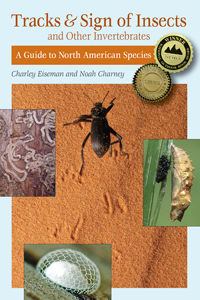On June 22, I was doing botanical work in a shrub swamp in Southbridge, Massachusetts when I found this 5.5-mm larva on the underside of a highbush blueberry (Ericaceae: Vaccinium corymbosum) leaf:

I find little tents like this from time to time on various trees and shrubs, and I’ve always assumed they’re the work of Machimia tentoriferella (Depressariidae), since that’s what it says on page 219 of Tracks & Sign of Insects. You can’t trust everything you read though, even if it’s something you wrote yourself, so I decided to take this opportunity to verify my assumption. I stuck the leaf in one of the little vials I carry in my backpack everywhere I go.
By July 3, the larva had grown to 8.5 mm and had spun its fourth tent on the same leaf. It had done some nibbling at the edges of the leaf in addition to its characteristic skeletonizing at either end of the tents.


Five days later, it had grown another millimeter and was eating large holes in the leaf.

On July 25, it had reached 11.5 mm and was still working on the original leaf, which had turned completely brown at this point.

By August 24, feeding on a fresh leaf, it had reached 16 mm and had developed a couple of yellow longitudinal stripes—hence the name “gold-striped leaftier.”

That was the last time I photographed it, but it was still feeding into early September. I never imagined that rearing a little micro-moth would take all summer. On September 28, the adult emerged, confirming that it was what I had assumed it to be.


It had pupated inside a tightly folded leaf. At no point was it actually a leaftier, which is a term reserved for larvae that use silk to fasten two or more leaves together.



The HOSTS Database records Machimia tentoriferella from maples (Acer spp.), birches (Betula spp.), hickory (Carya), walnuts (Juglans spp.), chestnut (Castanea dentata), beech (Fagus grandifolia), oaks (Quercus spp.), balsam poplar (Populus balsamifera), basswood (Tilia americana), elms (Ulmus spp.), apple (Malus), cherry/plum (Prunus spp.), mountain-ash (Sorbus), true ashes (Fraxinus spp.), lilac (Syringa vulgaris), buttonbush (Cephalanthus occidentalis), dogwoods (Cornus spp.), and viburnum. If that is a complete list of published host records (which it probably isn’t), this rearing from blueberry is the first recorded instance of M. tentoriferella using a host in the heath family (Ericaceae).



